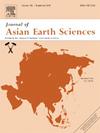Metamorphism and anatexis of high-pressure mafic granulites in the Dulan unit, North Qaidam, Northwestern Tibet
IF 2.4
3区 地球科学
Q2 GEOSCIENCES, MULTIDISCIPLINARY
引用次数: 0
Abstract
Metamorphism and anatexis of high-pressure (HP) mafic granulites are effective for revealing partial melting and metamorphic process in continental collisional orogenic belts. HP mafic granulites and associated adakitic leucosomes have been recognized in Dulan area, North Qaidam, however, the metamorphic evolution and the linkage between the metamorphism and anatexis remain ambiguous. Based on the petrographic textures and mineral assemblages, three phases of metamorphic evolution are recognized for the HP mafic granulites: (1) the amphibolite-facies prograde metamorphism, represented by mineral inclusions of plagioclase + amphibole + chlorite + quartz in the large-grained garnet; (2) the HP granulite-facies peak metamorphism, represented by garnet + matrix mineral assemblage: garnet + clinopyroxene ± amphibolite + plagioclase + kyanite + zoisite + quartz + rutile; (3) the retrograde metamorphic stage, represented by the symplectite of the fine-grained clinopyroxene + plagioclase in the large clinopyroxene and garnet grains, and the following intergrowth of light-green amphibolite + plagioclase on garnet rims. Conventional geothermobarometries yield the P-T conditions of 565–605 °C and 9.4–10.8 kbar, 15.2–17.9 kbar and 830–925 °C, and 720–795 °C and 11.8–13.2 kbar for the amphibolite-facies prograde metamorphism, the HP granulite-facies peak metamorphism, and the retrograde metamorphic stage, respectively. The P-T pseudosection shows that the HP mafic granulite experienced a clockwise P-T path with the peak stage at 891–910 °C/17.2 kbar and a partial melting degree of 45–50 %, forming the adakitic melts/TTGs. Zircon U-Pb dating suggests that the HP mafic granulites experienced a magmatic event at 458 ± 5 Ma followed by a metamorphic and anatectic event at 445 ± 2 Ma. The HP mafic granulites are rich in light rare earth elements and large ion lithophile elements (e.g., Ba, Sr, Th, U) and poor in high field strength elements (e.g., Nb, Ta, Ti), showing arc-related geochemical affinities. These arc magmatic rocks were buried to depths exceeding 56 km and heated to ca. 900 °C during collisional orogeny, and experienced HP granulite-facies metamorphism and anatexis. Geochronological and geochemical data demonstrate that the leucosome within the HP mafic granulite in the Dulan area may have been generated by the partial melting of metagabbro under HP granulite-facies conditions in an arc root, which migrated and converged to form the coeval tonalite plutons, with HP mafic granulite and garnet pyroxenite representing the residue. These results will provide key insights into the geotectonic processes of metamorphism and anatexis of arc magmatic rocks within the upper plate of the subduction zone as well as their significance for orogenesis.
高压基性麻粒岩的变质和深熔作用是揭示大陆碰撞造山带部分熔融和变质过程的有效条件。柴达木北部都兰地区发现了镁铁质麻粒岩及其伴生的绿质白粒岩,但其变质演化及其与深熔作用的联系尚不清楚。根据岩石结构和矿物组合特征,HP基性麻粒岩的变质演化可分为三个阶段:(1)角闪岩相递进变质作用,以大粒石榴石中斜长石+角闪孔+绿泥石+石英矿物包裹体为代表;(2) HP麻粒岩相峰变质作用,以石榴石+基质矿物组合为代表:石榴石+斜辉石±角闪石+斜长石+蓝晶石+黝帘石+石英+金红石;(3)逆行变质阶段,以细粒斜辉石+斜长石在大斜辉石和石榴石颗粒中嵌合为代表,随后在石榴石边缘上形成浅绿色角闪石+斜长石的共生。常规地温测量结果表明,角闪岩相进变质期、HP麻粒岩相峰变质期和逆变质期的P-T条件分别为565 ~ 605℃、9.4 ~ 10.8 kbar、15.2 ~ 17.9 kbar、830 ~ 925℃和720 ~ 795℃、11.8 ~ 13.2 kbar。P-T伪剖面显示,HP基性麻粒岩经历顺时针P-T路径,峰值阶段为891 ~ 910℃/17.2 kbar,部分熔融程度为45 ~ 50%,形成adakic熔体/TTGs。锆石U-Pb测年表明,高压镁质麻粒岩经历了458±5 Ma的岩浆活动,随后经历了445±2 Ma的变质和退熔活动。高压镁基性麻粒岩富含轻稀土元素和大离子亲石元素(Ba、Sr、Th、U),缺乏高场强元素(Nb、Ta、Ti),具有与弧相关的地球化学亲和力。这些弧状岩浆岩在碰撞造山运动中埋藏深度超过56 km,加热至900℃左右,经历了HP麻粒岩相变质和深熔作用。地质年代学和地球化学资料表明,都兰地区高压基性麻粒岩内的白色小体可能是高压麻粒岩相条件下的变长岩在弧根内部分熔融形成的,这些变长岩在弧根内迁移汇聚形成同代的闪长岩岩体,其残余物为高压基性麻粒岩和石榴石辉石岩。这些结果将为认识俯冲带上板块内弧岩浆岩的变质和深熔作用的大地构造过程及其造山意义提供重要依据。
本文章由计算机程序翻译,如有差异,请以英文原文为准。
求助全文
约1分钟内获得全文
求助全文
来源期刊

Journal of Asian Earth Sciences
地学-地球科学综合
CiteScore
5.90
自引率
10.00%
发文量
324
审稿时长
71 days
期刊介绍:
Journal of Asian Earth Sciences has an open access mirror journal Journal of Asian Earth Sciences: X, sharing the same aims and scope, editorial team, submission system and rigorous peer review.
The Journal of Asian Earth Sciences is an international interdisciplinary journal devoted to all aspects of research related to the solid Earth Sciences of Asia. The Journal publishes high quality, peer-reviewed scientific papers on the regional geology, tectonics, geochemistry and geophysics of Asia. It will be devoted primarily to research papers but short communications relating to new developments of broad interest, reviews and book reviews will also be included. Papers must have international appeal and should present work of more than local significance.
The scope includes deep processes of the Asian continent and its adjacent oceans; seismology and earthquakes; orogeny, magmatism, metamorphism and volcanism; growth, deformation and destruction of the Asian crust; crust-mantle interaction; evolution of life (early life, biostratigraphy, biogeography and mass-extinction); fluids, fluxes and reservoirs of mineral and energy resources; surface processes (weathering, erosion, transport and deposition of sediments) and resulting geomorphology; and the response of the Earth to global climate change as viewed within the Asian continent and surrounding oceans.
 求助内容:
求助内容: 应助结果提醒方式:
应助结果提醒方式:


